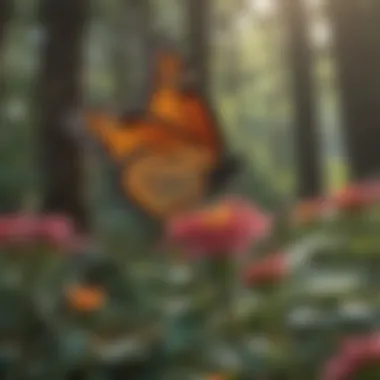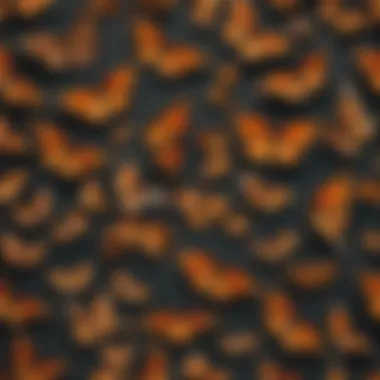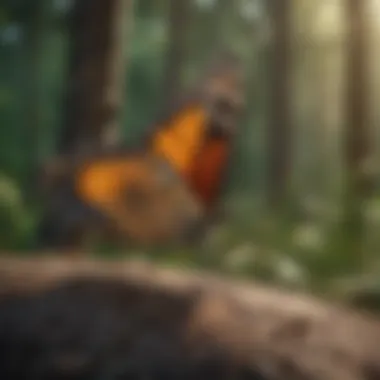Monarch Butterfly Protection: Challenges and Conservation


Intro
The listing of the monarch butterfly under the Endangered Species Act has profound implications for biodiversity and ecosystem health. This decision marks a significant step in acknowledging both the biological and ecological challenges faced by this iconic species. The decline of monarch populations is not an isolated phenomenon; it reflects broader environmental issues that demand urgent attention.
Understanding these implications provides a framework for effective conservation strategies. Stakeholders ranging from forestry professionals to community members must engage in a collaborative effort to address the factors that contribute to the monarch's decline. By examining the nuances of this situation, we can appreciate the monarch's role in the ecosystem and outline actionable paths for recovery.
In this article, we will explore the various dimensions of monarch butterfly conservation, including its ecological significance, the socio-economic impacts of its decline, and the strategies that can be employed to restore and preserve its habitat.
Prelims to the Monarch Butterfly
The significance of the monarch butterfly extends beyond its distinct appearance and migratory behavior. In the realms of ecology and conservation, the monarch serves as an indicator species, reflecting the health of broader ecosystems. Understanding the monarch’s biology and its role within the environment is crucial for informed conservation strategies. This section provides essential insights and sets the stage for a deeper exploration of the challenges and implications surrounding its recent endangered listing.
Defining the Monarch Butterfly
The monarch butterfly, scientifically known as Danaus plexippus, is a striking insect characterized by its vivid orange and black wings. This species is well-known for its remarkable migration, traveling thousands of miles from North America to central Mexico to escape winter's harsh conditions. Monarchs undergo a fascinating lifecycle that consists of four stages: egg, larva (caterpillar), pupa (chrysalis), and adult. Each stage presents specific vulnerabilities, highlighting how environmental changes can adversely affect their survival.
Notably, the monarch’s reliance on milkweed plants for larval development underscores its specific habitat needs. As such, any threats to milkweed populations directly impact monarch success rates. Understanding the description and lifecycle of the monarch butterfly helps build a foundational knowledge that is vital for conservation efforts.
The Importance of Monarchs in Ecosystems
Monarch butterflies play a crucial role in maintaining healthy ecosystems. Their journey as pollinators contributes to the reproductive success of numerous flowering plants. Pollination is essential not only for plant reproduction but also for supporting food webs that sustain diverse wildlife. Monarchs help fertilize flowers, promoting the growth of many species, which facilitates habitat stability.
Given their migratory pattern, monarch butterflies also serve as a bridge in the ecosystems they inhabit during migration. They create links between different ecological regions and contribute to nutrient cycling. The decline of the monarch population signals potential dysfunctions within the ecosystems of which they are a part.
"The loss of a keystone species like the monarch butterfly can lead to significant ecological shifts, impacting biodiversity and ecosystem resilience."
In summary, the definition and ecological significance of monarch butterflies are central to understanding the implications of their current conservation status. Their delicate balance within ecosystems makes them an essential focal point for conservation strategies aimed at protecting not just monarchs, but the broader environmental health they represent.
Conservation Status and Listing
The conservation status and listing of the monarch butterfly is a pivotal issue in the broader context of wildlife preservation. Understanding this topic provides insights into the vulnerabilities of the monarch population and the regulatory measures that aim to combat its decline. The recent actions taken under the Endangered Species Act have far-reaching implications for both the species itself and the ecosystems that depend on it. The listing highlights the urgency of conservation efforts and brings to light the systemic challenges faced in environmental and ecological preservation.
The monarch's status as an endangered species signals not only a significant biological concern but also a necessity for legal frameworks to safeguard its survival. Recognizing the conservation status brings attention to the interconnectedness of species within ecosystems and the delicate balance that sustains biodiversity. As such, it encourages efforts to restore habitats that are crucial for the survival of monarchs and other flora and fauna.
Overview of the Endangered Species Act
The Endangered Species Act (ESA) is a key legislative tool in the United States aimed at protecting species at risk of extinction. Enacted in 1973, the ESA provides a framework for the conservation of threatened and endangered animals and their habitats. Under this act, species like the monarch butterfly can receive legal protection, which is essential for driving conservation initiatives.
The significance of the ESA lies in its ability to compel action toward species recovery. It mandates federal agencies to ensure that their actions do not jeopardize the continued existence of any listed species. Furthermore, it requires the development of recovery plans that outline necessary actions to improve the status of a species, which can include habitat protection, restoration, and monitoring efforts.
Recent Developments in Monarch Listing
In recent years, the conversation around the monarch butterfly's listing has intensified. The U.S. Fish and Wildlife Service has recognized the need to respond to alarming trends observed in monarch populations, leading to the proposed listing of the species as endangered. This move reflects growing scientific consensus about the severity of threats faced by the monarch, including habitat loss, climate change, and pesticide use.
Recent developments also included public consultations and input from various stakeholders in the environmental sector. Conservationists argue that the listing is crucial for mobilizing resources and raising public awareness about the plight of the monarch. Advocacy groups have emphasized the importance of habitat restoration, not only for monarchs but for the entire ecosystem.
The butterfly's population has decreased by nearly 90% in recent decades, prompting significant concern across ecological and conservation communities.
The decision to list monarchs under the ESA is a testament to the challenges in conserving migrating species that rely on specific habitats across vast geographical ranges. It highlights the need for coordinated conservation strategies that address both local and migratory needs. The challenge ahead lies in effectively implementing these strategies and fostering collaboration among different sectors of society.
Factors Contributing to Decline
The decline of the monarch butterfly is not a single issue but a intertwining of multiple factors. Understanding these elements is crucial for developing effective conservation strategies. Many elements contribute to the decline, including habitat loss and fragmentation, climate change, pesticide use and management practices, as well as disease and predation. Analyzing these factors, we can identify their effects, determine their significance, and consider ways to mitigate them effectively.


Habitat Loss and Fragmentation
Habitat loss remains one of the primary drivers behind the decrease in monarch butterfly populations. Urbanization, agricultural expansion, and industrial development lead to destruction of the milkweed plants and flowering plants that monarchs need. The increase in monoculture farming practices limits the diversity of plants available for the butterflies to feed on and lay eggs.
Fragmentation of habitat also poses a significant threat. When natural areas are broken up into smaller, isolated patches, it disrupts the migration routes and breeding cycles of monarchs. These fragmented habitats tend to offer fewer resources, making it hard for butterflies to find food and mates.
Climate Change Impacts
Climate change presents varied challenges. Changes in temperature and precipitation patterns influence the availability of critical habitats. Monarchs are sensitive to climatic shifts, which can affect their migratory patterns. For example, warming temperatures can lead to early blooming of plants, which may not coincide with the monarch’s migration schedule. Climate change can also increase the frequency and severity of extreme weather events. Storms can destroy habitats and disrupt migration, making survival more difficult.
Pesticide Use and Management Practices
The widespread use of pesticides in agricultural landscapes has a profound impact on monarch populations. While pesticides are generally used to control pests, they do not discriminate between harmful insects and beneficial pollinators. Monarch larvae feed exclusively on milkweed, which is often sprayed with herbicides or insecticides. Such chemicals are toxic and can lead to mortality of caterpillars, drastically affecting the population. Integrated pest management practices, which reduce reliance on chemical pesticides, should be encouraged to mitigate this issue.
Disease and Predation
Another factor affecting monarch populations is disease and predation. Monarch butterflies face threats from parasites such as the protozoan Ophryocystis elektroscirrha, which can weaken and kill caterpillars. Increased parasite loads can be linked to habitat stressors, including poor nutrition due to food scarcity.
Predation from birds and other natural predators also plays a role. The toxic chemicals in monarchs’ bodies, which they acquire from milkweed, deter many predators. However, if the predator population increases or if alternative food sources for predators decrease, monarch eggs and caterpillars can suffer.
Each of these factors interrelates, creating a complex web of challenges. A thorough understanding can guide effective conservation strategies. Institutions and organizations must work collaboratively to implement solutions to protect this important species.
Ecological Implications of Monarch Decline
The decline of monarch butterflies extends beyond the loss of a single species. It represents a profound disruption within the ecosystems they inhabit. Within this context, understanding the ecological implications is paramount. Monarchs play critical roles that extend into various facets of ecological balance. Their absence can trigger a cascade of effects that ultimately impact not only other species but also the health of the environment itself.
Role of Monarchs in Pollination
Monarch butterflies are not merely beautiful insects; they are also significant pollinators. In many environments, they contribute to the pollination of various plants, including economically essential crops. Their feeding habits encourage plant reproduction through the process of pollination, which is a critical link in the food web.
Without monarchs, several plant species may face challenges in reproducing and thriving. This could lead to decreased plant diversity, which in turn affects herbivores that rely on these plants for sustenance. Moreover, many flowering plants depend solely on specific pollinators. Losing monarchs alters the dynamic of plant-pollinator interactions, with potential reductions in both plant growth and ecosystem resilience. Therefore, their decline significantly threatens agricultural systems, which rely on these natural pollinators.
Impact on Biodiversity
Biodiversity is a crucial element in maintaining ecosystem functionality and stability. The presence of monarch butterflies contributes to this biodiversity. Their migration patterns connect different geographical areas, allowing for genetic exchange among plant populations and other pollinators. Monarchs not only support the health of their direct environment but also enhance the overall biodiversity of entire regions.
A decline in their population can lead to simplification of ecosystems. Simple ecosystems are often more vulnerable to pests, diseases, and environmental changes. Additionally, various species that depend on monarchs as a food source may decline, further exacerbating the issues related to biodiversity loss. In summary, the interplay between monarch butterflies and the plants they pollinate underscores the intricate relationships within ecosystems.
"The decline of pollinators like monarch butterflies poses immediate risks to biodiversity and ecosystem functionality. Their role is vital to sustain the intricate web of life."
Ultimately, the ecological implications of monarch decline must not be overlooked. Addressing these challenges is not only about saving a species; it is about preserving the health of entire ecosystems and, by extension, our agricultural practices and natural environments.
Socio-Economic Impacts
Understanding the socio-economic impacts of the monarch butterfly listing is crucial for grasping the broader significance of this decision. The health of ecosystems directly influences agriculture, local economies, and cultural practices. Monarchs serve not only as vital pollinators but also as symbols within various communities, thus intertwining ecological balance with economic sustainability and cultural identity.
Effects on Agriculture and Economy
Monarch butterflies play a critical role in pollination, which affects many crops. Their presence contributes to the fertilization of plants, directly influencing crop yields. A decline in their population could result in reduced yields for certain fruits, vegetables, and flowers. This leads to economic ramifications for farmers and local economies reliant on agriculture. Often, farmers depend on pollinators like monarchs for maximizing their harvests, which in turn supports their livelihoods.
Key points to consider about agricultural effects include:
- Reduced Crop Yields: As mentioned, fewer pollinators can lead to lower yields, impacting local food supply.
- Increased Production Costs: Farmers may need to invest more in artificial pollination methods or alternative crops that do not rely on such insects.
- Economic Stability: The agricultural economy often depends on diverse crops that rely on effective pollination; loss of monarchs can destabilize this balance.
With regard to tourism, areas known for their monarch populations could see a decrease in visitors if monarch numbers dwindle. This decrease in eco-tourism represents a significant loss for local businesses that benefit from the economic influx that comes with seasonal visitors who come specifically to witness the majestic migration of the monarch butterfly.


Cultural Significance of Monarch Butterflies
The monarch butterfly holds cultural importance in various communities. Often regarded as symbols of change and hope, monarchs feature prominently in local folklore and art. Their migration is celebrated in festivals, emphasizing the interconnectedness of nature and human experience.
Cultural aspects to note include:
- Symbolism: In many cultures, butterflies, including monarchs, represent transformation and the beauty of nature's cycles.
- Educational Opportunities: Monarchs serve as focal points for educational initiatives, teaching about ecology and conservation to younger generations.
- Art and Literature: Monarchs inspire numerous forms of art, literature, and storytelling, enriching cultural heritage and identity.
"The decline of the monarch butterfly extends beyond ecological loss; it challenges the spirit and identity of communities that celebrate them."
In summary, the socio-economic impacts of the monarch butterfly listing reveal a complex web of interactions between ecological health, agriculture, and cultural identity. Recognizing these relationships is vital for a coordinated response to conservation that integrates environmental, economic, and social aspects.
Challenges in Conservation Efforts
The conservation of the monarch butterfly is intricately tied to numerous challenges that stem from various factors. Understanding these challenges is crucial for effective conservation strategies. The monarch population has drastically declined due to multifaceted issues, including regulatory hurdles and financial constraints. Recognizing these challenges allows stakeholders to navigate the complexities surrounding conservation efforts effectively.
Policy and Regulatory Challenges
The regulatory framework governing conservation efforts is often intricate and, at times, counterproductive. Policymakers grapple with balancing ecological needs with economic interests. For instance, land-use policies might prioritize agricultural development over habitat preservation. This conflict can lead to significant habitat loss, undermining the species' recovery. Moreover, current regulations may lack the flexibility required to adapt to changing environmental conditions or new information related to monarch populations.
One notable aspect is the process of listing the monarch butterfly under the Endangered Species Act. While this designation elevates attention and protective measures, it can also lead to resistance from industries concerned about regulatory impacts. These industries might view such regulations as a threat to their operations rather than as a necessary safeguard for ecological balance. Hence, finding common ground requires comprehensive dialogue among stakeholders, including farmers, conservationists, and policymakers.
Funding and Resource Allocation
The financial aspect of conservation efforts cannot be overstated. Adequate funding is indispensable for implementing effective restoration programs and research initiatives. Presently, many conservation programs operate on tight budgets, limiting their capacity to execute extensive projects. Moreover, funding often follows existing priorities, which may not always align with immediate monarch conservation needs. This misalignment results in gaps in essential research initiatives and habitat restoration projects.
"Sustainable funding is a pillar of successful conservation efforts. Without it, strategic plans remain theoretical, lacking practical implementation."
Additionally, the competition for resources can leave monarch conservation at a disadvantage, as other environmental issues may take precedence. It is essential for conservation organizations to advocate for more dedicated resources toward monarch protection. Forming partnerships with both public and private sectors can be a strategy to harness additional financial support.
In summary, the challenges in conservation efforts for the monarch butterfly are complex and multifaceted. Policies must be adaptive and inclusive to foster collaboration. At the same time, securing adequate funding is crucial to translate strategies into actionable conservation results. The implications of these challenges extend beyond the monarch butterfly, affecting biodiversity and ecosystem health as a whole.
Strategies for Monarch Conservation
The conservation of the monarch butterfly is a multifaceted endeavor that requires collaborative efforts across various sectors. Addressing the decline of this species not only restores its populations but also enhances ecosystem health. The strategies employed for monarch conservation will include habitat restoration, community engagement, and partnerships with conservation organizations. Each approach plays a critical role in ensuring the long-term survival of this species.
Habitat Restoration Initiatives
Habitat restoration is foundational for the recovery of monarch populations. The monarch butterfly relies on specific habitats that provide essential resources such as milkweed for larval development and nectar sources for adults. Restoring native plant populations is crucial. Initiatives can include replanting native flora, removing invasive species, and creating pollinator gardens.
These efforts can have significant benefits, such as:
- Improvement of local biodiversity,
- Enhanced ecosystem services,
- Support for other pollinators and wildlife.
Furthermore, public land managers and private landowners must collaborate to prioritize sites with high restoration potential. Monitoring progress and adapting strategies based on effectiveness is vital for long-term success.
Community Engagement and Education
Engaging communities in conservation efforts creates awareness and fosters a sense of responsibility towards the environment. Educational programs emphasize the importance of monarch butterflies and pollinator health. Schools, local organizations, and civic groups can play an active role in spreading knowledge.
Some key components of community initiatives may include:
- Workshops: Providing resources and training on pollinator habitat creation.
- Citizen Science Projects: Involving the public in data collection to track monarch population trends.
- Events: Hosting butterfly counts or festivals to celebrate and promote monarch conservation.


These efforts not only increase community involvement but also empower individuals to take action. Understanding their connection to local ecosystems can enhance people's commitment to conservation.
Partnerships with Conservation Organizations
Collaborative partnerships are essential for maximizing conservation impact. Various organizations focus on monarch conservation, each offering unique expertise and resources. Building alliances strengthens the overall effectiveness of the initiatives.
Some benefits of partnerships include:
- Resource Sharing: Organizations can pool their resources to fund larger projects.
- Expertise Exchange: Access to specialized knowledge and skills promotes innovation in conservation strategies.
- Broader Reach: Partnerships can enhance outreach efforts to engage more stakeholders, from farmers to urban planners.
Successful examples of partnerships include collaborations between non-profit organizations, government agencies, and academic institutions. These alliances can work toward policy advocacy, habitat protection, and funding for critical conservation projects.
Engaging in a collaborative framework allows stakeholders to share visions and resources, amplifying their conservation efforts.
In summary, strategies for monarch conservation encompass habitat restoration, community engagement, and strong partnerships. Each strategy plays an integral role in sustaining monarch populations and protecting the broader ecosystems they inhabit. Developing these strategies effectively ensures that we preserve the beauty and ecological significance of monarch butterflies for future generations.
Monitoring and Research Needs
Monitoring and research play a critical role in the conservation of the monarch butterfly. Understanding the current status and trends of monarch populations is essential for developing effective conservation strategies. Without adequate data, efforts to protect this species could be misdirected or ineffective. Monitoring helps to assess the effectiveness of conservation actions and guides future initiatives. Additionally, research can uncover the underlying causes of decline and the impacts of various threats affecting monarchs.
A systematic approach is necessary for addressing gaps in knowledge. This includes long-term population studies and habitat assessments. For instance, monitoring migration patterns is vital, as the wings of monarchs span thousands of miles during their migration from North America to central Mexico. By tracking these patterns, conservationists can identify critical stops along their migratory routes, which might need protection and restoration efforts.
"Effective monitoring and research are cornerstones in the effort to reverse the decline of the monarch butterfly and ensure its survival."
Current Research Initiatives
Several research initiatives currently focus on monarch butterflies, yielding valuable insights into their biology and ecology. One prominent project is the Monarch Joint Venture, which encourages collaboration among various stakeholders to conduct research and promote conservation efforts. This initiative facilitates data collection from citizen scientists, providing crucial information on monarch sightings and behaviors across diverse habitats.
Another significant effort is led by researchers studying the physiological responses of monarchs to climate change. Such studies examine how changes in temperature and weather patterns affect breeding, migration, and survival rates. These findings are integral to designing effective habitat restoration projects that can mitigate the impacts of a changing climate.
Additionally, studies on the effects of pesticides on monarch larvae are vital. The focus is on how different pesticide applications influence not just mortality but also development and behaviors. By understanding these dynamics, better management practices can be established that protect monarchs while allowing for agricultural production.
Future Research Directions
Looking forward, several key research directions will enhance the understanding of monarch butterflies and their ecosystems. Future studies should prioritize the effects of habitat fragmentation on monarch populations. As urbanization continues, determining how fragmented landscapes affect migration and breeding success will guide conservation efforts.
Another important research direction involves exploring genetic diversity among monarch populations. Understanding the genetic variations allows researchers to assess the resilience of different populations to environmental stresses. This information is critical in determining how to best manage and conserve these butterflies across various regions.
Finally, integrated research initiatives that combine ecological, social, and economic dimensions will be vital. Such an approach can help assess the broader implications of conservation strategies, including how these efforts can yield benefits for local communities, agriculture, and biodiversity as a whole.
By focusing on these areas, the conservation community can better position itself to tackle the complex challenges faced by the monarch butterfly.
Epilogue
The conclusion of this article holds significant value. It serves as a synthesis of all points discussed, reinforcing the implications of the monarch butterfly's recent listing under the Endangered Species Act. This section is not merely a recap, but an essential part of emphasizing the urgency of conservation efforts. Understanding the various factors contributing to the continuous decline in monarch populations allows for well-informed decision-making among stakeholders in conservation.
Here, we tie together the biological, ecological, and socio-economic aspects. By highlighting the unique challenges faced and the strategies proposed for restoration, the conclusion resonates with the reader. It reminds us that each element discussed is interconnected, thus making the call for action more impactful. The urgency of the situation surrounding monarch butterflies invites stakeholders to recognize the significance of their role in this conservation narrative.
Summary of Key Points
- The monarch butterfly is essential for pollination and maintains biodiversity within ecosystems.
- The listing of the monarch under the Endangered Species Act raises awareness of its declining populations.
- Critical factors contributing to decline include habitat loss, climate change, pesticide use, and disease.
- Conservation strategies should focus on habitat restoration, community engagement, and partnerships.
- Ongoing research and monitoring are vital for understanding population dynamics and effectiveness of strategies.
Call to Action for Conservation Efforts
The survival of the monarch butterfly hinges on collective action. Each individual can contribute to conservation efforts through various means:
- Promote native planting: Planting native milkweed and nectar sources in gardens can help provide essential habitats for monarchs.
- Support local initiatives: Engage with community-based conservation programs that focus on restoring habitats.
- Advocate for policy changes: Push for policies that protect natural habitats and reduce pesticide usage.
Together, we can ensure that future generations experience the beauty of the monarch butterfly and the ecological benefits it provides.
In summary, this call to action drives home the need for a multifaceted approach to conserve monarch populations. Only through collaboration and dedication can substantial progress be made in combating the decline of this vital species.







